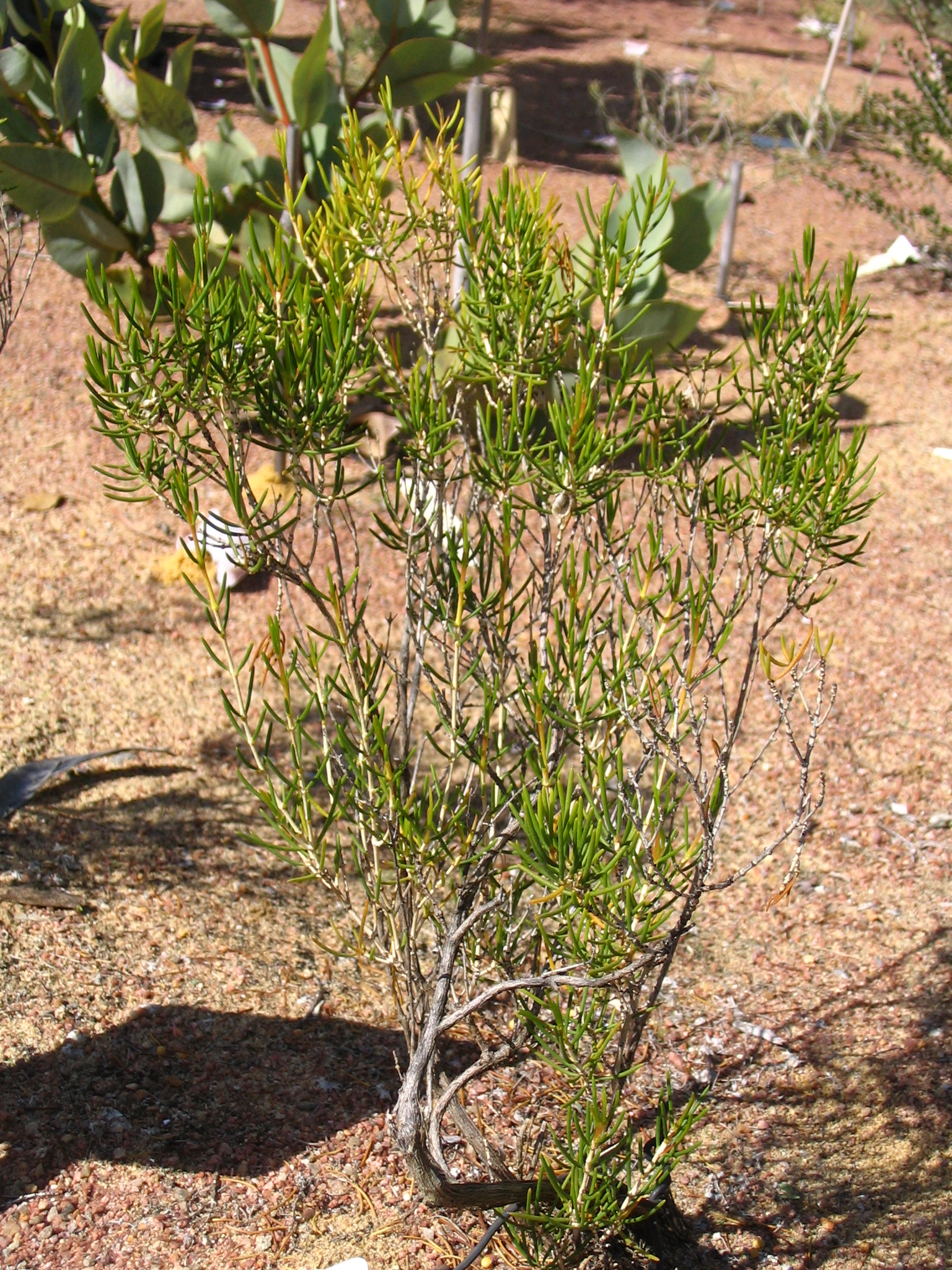Verticordia Galeata on:
[Wikipedia]
[Google]
[Amazon]
''Verticordia galeata'' is a flowering plant in the myrtle family,

Myrtaceae
Myrtaceae, the myrtle family, is a family of dicotyledonous plants placed within the order Myrtales. Myrtle, pōhutukawa, bay rum tree, clove, guava, acca (feijoa), allspice, and eucalyptus are some notable members of this group. All speci ...
and is endemic to the south-west
The points of the compass are a set of horizontal, radially arrayed compass directions (or azimuths) used in navigation and cartography. A compass rose is primarily composed of four cardinal directions—north, east, south, and west—each se ...
of Western Australia. It is a woody shrub with thin, pointed cylinder-shaped leaves and heads of bright yellow flowers on the ends of the branches in spring.
Description
''Verticordia galeata'' is a shrub which grows to high and wide and which is irregularly branched. Its leaves are linear in shape, almost circular in cross-section, long with a pointed end. The flowers are honey-scented and arranged in corymb-like groups near the ends of the branches, each flower on an erect stalk long. Thefloral cup
In angiosperms, a hypanthium or floral cup is a structure where basal portions of the calyx, the corolla, and the stamens form a cup-shaped tube. It is sometimes called a floral tube, a term that is also used for corolla tube and calyx tube. It ...
is shaped like half a sphere, about long, glabrous and has a slightly warty surface. The sepals are bright yellow, spreading, long, with 7 to 9 densely hairy lobes. The petal
Petals are modified Leaf, leaves that surround the reproductive parts of flowers. They are often advertising coloration, brightly colored or unusually shaped to attract pollinators. All of the petals of a flower are collectively known as the ''c ...
s are also bright yellow, erect , with long, spreading, finger-like projections. The stamens possess an inflated appendage, a hood, that nearly covers their tips and the staminodes are pointed and triangular. The style is straight, long, and glabrous. Flowering time is from September to November.
This verticordia is similar to '' V. chrysantha, V, chrysanthella and V. nobilis'' but is distinguished from them by its longer leaves, longer flower stalks and bright yellow, non-fading flowers.
Taxonomy and naming
''Verticordia galeata'' was first formally described byAlex George Alexander or Alex George may refer to:
*Alex George (botanist) (born 1939), Australian botanist
* Alexander L. George (1920–2006), American political scientist
* Alexander George (philosopher), American philosopher
*Alex George (motorcyclist), Sc ...
in 1991 and the description was published in '' Nuytsia'' from specimens collected near the Murchison River in Kalbarri National Park by Alex George and Bob Wemm. The specific epithet
In taxonomy, binomial nomenclature ("two-term naming system"), also called nomenclature ("two-name naming system") or binary nomenclature, is a formal system of naming species of living things by giving each a name composed of two parts, bot ...
(''galeata'') is derived from the Latin word ''galeatus'' meaning "helmeted".
George placed this species in subgenus ''Chrysoma'', section ''Jugata'' along with '' V. chrysanthella'', '' V. chrysantha'', '' V. brevifolia'', '' V. coronata'', '' V. amphigia'' and '' V. laciniata''.
Distribution and habitat
The known populations, of which there are few, are found on red sand, amid sandstone gorges, in the open scrublands of its small range around the lower Murchison River in the northern section of the Geraldton Sandplainsbiogeographic region
An ecoregion (ecological region) or ecozone (ecological zone) is an ecologically and geographically defined area that is smaller than a bioregion, which in turn is smaller than a biogeographic realm. Ecoregions cover relatively large areas of l ...
.
Conservation
''Verticordia galeata'' is classified as " Priority Two" by the Western Australian GovernmentDepartment of Parks and Wildlife
The Department of Parks and Wildlife (DPaW) was the department of the Government of Western Australia responsible for managing lands described in the ''Conservation and Land Management Act 1984'' and implementing the state's conservation and e ...
meaning that it is poorly known and from only one or a few locations. It does not possess a lignotuber, so is susceptible to altered fire regimes; the distribution range is within the Kalbarri National Park, a protected area that has become vulnerable to high intensity fires.
Use in horticulture
Flowers on cultivated specimens of this plant last much longer than those in the wild and their bright colour and sweet scent make them attractive garden plants. Plants have been propagated from cuttings and bygrafting
Grafting or graftage is a horticultural technique whereby tissues of plants are joined so as to continue their growth together. The upper part of the combined plant is called the scion () while the lower part is called the rootstock. The succ ...
onto ''Darwinia citriodora
''Darwinia citriodora'', commonly known as lemon-scented darwinia or lemon scented myrtle, is a plant in the myrtle family Myrtaceae and is Endemism, endemic to the Southwest Australia, south-west of Western Australia. It is a shrub with oblong t ...
'' rootstock. Established plants prefer full sun and well drained soil and some specimens have even performed well in winter-rainfall areas.
References
{{Taxonbar, from=Q7922899galeata
Galeata ( rgn, Gagliêda) is a ''comune'' (municipality) in the Province of Forlì-Cesena in the Italian region Emilia-Romagna, located about southeast of Bologna and about southwest of Forlì.
Galeata borders the following municipalities: Civ ...
Rosids of Western Australia
Eudicots of Western Australia
Plants described in 1991